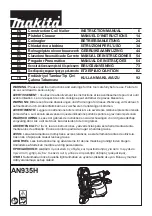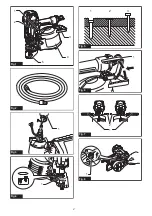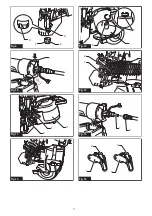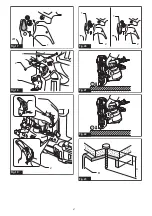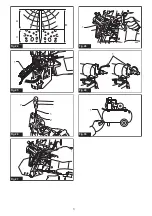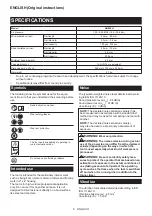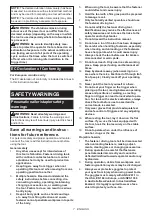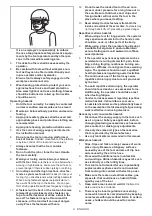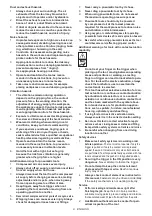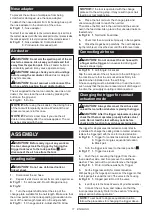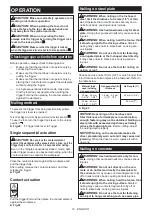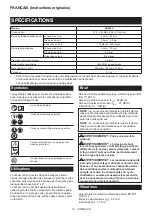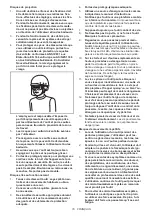
12 ENGLISH
OPERATION
CAUTION:
Make sure all safety systems are in
working order before operation.
CAUTION:
When operating the tool, do not
close the face to the tool. Also keep hands and
feet away from the ejection port area.
CAUTION:
When not operating the tool,
always lock the trigger by turning the trigger lock
lever to the lock position .
CAUTION:
Make sure that the trigger is locked
when the trigger lock lever is set to the lock position .
Checking proper action before operation
Before operation, always check following points.
— Make sure that the tool does not operate only by
connecting the air hose.
— Make sure that the tool does not operate only by
pulling the trigger.
— Make sure that the tool does not operate only by
placing the contact element against the workpiece
without pulling the trigger.
— In single sequential actuation mode, make sure
that the tool does not operate when pulling the
trigger first and then placing the contact element
against the workpiece.
Nailing method
To prevent the trigger from being accidentally pulled,
the trigger lock lever is provided.
To lock the trigger, turn the trigger lock lever to the lock position .
To use the tool, turn the trigger lock lever to the unlock
position .
►
Fig.20:
1.
Trigger lock lever
2.
Trigger
Single sequential actuation
CAUTION:
Do not place the contact element
against the workpiece with excessive force. Also, pull the
trigger fully and hold it on for 1-2 seconds after nailing.
Even in the “Single sequential actuation” mode, half-
pulled trigger causes an unexpected nailing, when the
contact element re-contacts the workpiece.
Place the contact element against the workpiece and
pull the trigger fully.
After nailing, release the contact element, and then
release the trigger.
►
Fig.21
Contact actuation
Pull the trigger first and then place the contact element
against the workpiece.
►
Fig.22
Nailing on steel plate
WARNING:
When nailing on the C-shaped
steel, limit the thickness to 3.2 mm (1/8") or thin-
ner.
Otherwise the tool will bounce severely and a
nail struck back, causing serious injuries.
WARNING:
Use hardened nails only for steel
plate.
Using other purposed nails may cause serious
injuries.
WARNING:
When nailing, hold the tool so that
it stands upright to the driving surface.
Slanted
nailing may cause nails to strike back, causing seri-
ous injuries.
WARNING:
Do not use the tool for fastening
a corrugated plate or the C-shaped steel directly.
It may cause nails to strike back, causing serious
injuries.
WARNING:
Do not use the tool for nailing on
ceiling or roof.
Choose and use nails 10 mm (3/8") or much longer than
total thickness of all workpiece to be fastened. Refer to
the table below.
Material thick-
ness including
C-shaped steel (A)
C-shaped steel (B)
thickness
Nail length (C)
30 mm - 35 mm
(1-3/16" - 1-3/8")
1.6 mm - 3.2 mm
(1/16" - 1/8")
45 mm (1-3/4")
35 mm - 40 mm
(1-3/8" - 1-5/8")
50 mm (2")
►
Fig.23
NOTICE:
Depending on the hardness and
total thickness of all workpiece in combination,
enough fastening may not be obtained. Nailing on
steel plate with excessive depth may extremely
reduce the fastening force.
Before nailing, adjust
the nailing depth properly.
NOTICE:
Nailing on the steel plate makes the
driver prematurely worn out and it may cause nail
jamming.
When the driver is worn, replace it with a
new one.
Nailing on concrete
WARNING:
Use hardened nails only for con-
crete.
Using other purposed nails may cause serious
injuries.
WARNING:
Do not nail directly on the con-
crete or do not fasten directly the steel plate to
the concrete.
It may cause concrete fragments to fly
off or nails to strike back, causing serious injuries.
WARNING:
When nailing, hold the tool so that
it stands upright to the driving surface.
Slanted
nailing may cause concrete fragments to fly off or
nails to strike back, causing serious injuries.
WARNING:
Do not use the tool for fastening
an object to hang something such as sewer pipe.

